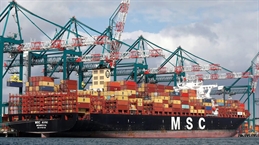
With the 2M Alliance between the two largest shipping lines, MSC and Maersk, coming to an end in February 2025 and Maersk then joining Hapag-Lloyd to form the Gemini Cooperation, it seems that MSC is already shifting its focus onto its own-operated services.
Sea-Intelligence said in a new report that MSC has been growing capacity market share for its stand-alone services (services offered outside the 2M alliance) on the Transpacific and Asia-Europe trades.

[Source: Sea-Intelligence]
"Figure 1 shows the share of Asia-North Europe capacity (3w avg.) offered by MSC on its stand-alone services, against those of Hapag-Lloyd and CMA CGM, the only other major carriers on the trade lane with stand-alone services," Sea-Intelligence pointed out in a statement.
"This increase for MSC should be seen not only in the context of the extreme pressure the markets are currently under but, of course, also in the context of the termination of the 2M alliance," it added.
Alan Murphy, CEO, Sea-Intelligence, said, "Clearly, MSC is beginning to carve out services on their own prior to the 2M termination date, whereas Maersk is not doing the same."
"It can also be seen that MSC began doing this before the Red Sea crisis – although an acceleration has clearly happened after the outbreak of the crisis," he added.
The report pointed out that in Asia-Mediterranean, the move from MSC to increase stand-alone capacity share pre-dates the Red Sea crisis, with MSC stand-alone services accounting for approximately 9% of deployed capacity in the trade lane since 2023-Q2.
A similar trend can also be seen on the two Transpacific trade lanes, especially on Asia to North America East Coast, where MSC have been increasing their stand-alone capacity market share from 3% to 6% in 2023-Q3.
On the Asia to North America West Coast trade lane, it said that MSC stand-alone services were introduced when the pandemic market tightened in 2020-Q3 and have held a somewhat consistent capacity market share of around 6%, outside of a temporary increase to around 12% during the height of the pandemic in late 2021.



